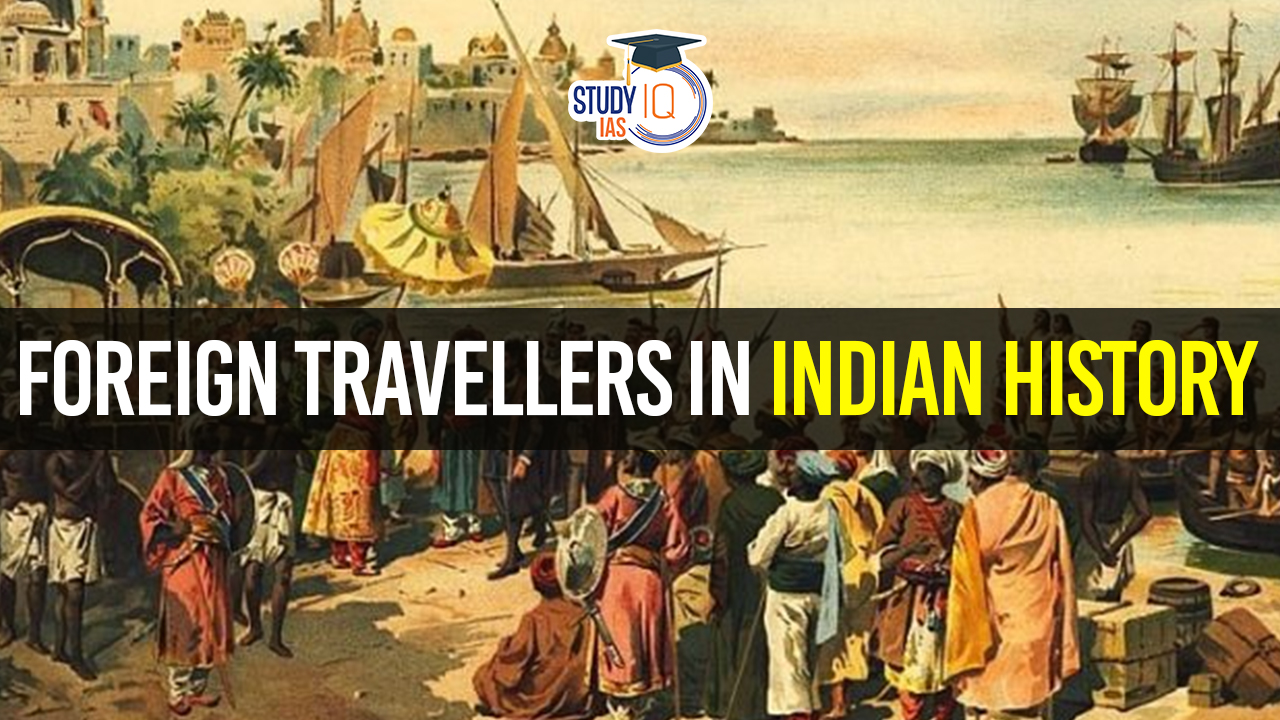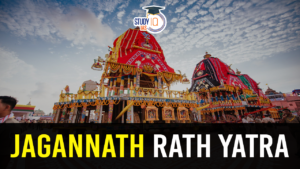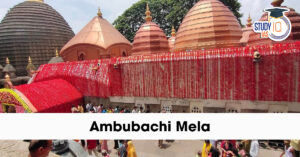Table of Contents
Foreign travelers such as Megasthenes and Hiuen Tsang in ancient times, and Ibn Battuta and Vasco da Gama in medieval and early modern periods, have left significant imprints on India’s history. These explorers, hailing from Greece to Morocco and beyond, documented their experiences, contributing crucial insights into India’s culture, trade, and society. Their accounts remain valuable sources for understanding the historical dynamics of the Indian subcontinent.
We’re now on WhatsApp. Click to Join
Foreign Travellers in Ancient India
Foreign travelers in ancient India, such as Megasthenes and Faxian, played crucial roles in shaping historical narratives.
- Megasthenes, a Greek ambassador in the 4th century BCE, provided insights into the Mauryan Empire’s court under Chandragupta Maurya.
- Faxian, a Chinese pilgrim in the 5th century CE, documented Gupta dynasty details and contributed to Buddhist knowledge.
- These early observers, alongside others like Hiuen Tsang, established enduring connections between India and the global community, leaving invaluable records that illuminate ancient Indian society, culture, and political landscapes. Their writings remain pivotal in understanding the historical dynamics of the Indian subcontinent.
Foreign Travellers in Medieval India
Medieval India attracted an array of foreign travelers who left significant accounts of their experiences.
- Ibn Battuta, a Moroccan explorer in the 14th century, documented the Delhi Sultanate’s political and cultural milieu during Muhammad bin Tughlaq’s reign.
- Marco Polo, the Italian merchant, offered insights into the economic history of Southern India during the Kakatiya and Pandyan rule.
- Jean-Baptiste Tavernier, a French gem merchant, traversed India during the 17th century, providing details on the Mughal Empire’s flourishing trade.
- These travelers contributed diverse perspectives, enriching our understanding of medieval Indian society, commerce, and governance through their valuable writings, which continue to be historical references.
List of Foreign Travellers in India
| Traveler | Time Period | Role/Title | Notable Works/Contributions |
| Megasthenes | 302-298 B.C. | Greek Ethnographer & Ambassador | Ambassador of Seleucus Nicator to Chandragupta Maurya
“Indika”: Descriptive account of ancient India, including geography. |
| Deimachos | 320-273 B.C. | Greek Ambassador | Sent by Antiochus I to Bindusāra or Amitraghāta, successor of Chandragupta Maurya
Provided insights into contemporary society and polity. |
| Ptolemy | 130 A.D. | Greek Geographer | “The Geography of India”: Describes ancient Indian geography. |
| Faxian | AD 405-411 | Chinese Wayfarer | Walked to India during Chandragupta Vikramaditya’s era
“Record of Buddhist Kingdom”: Details about Gupta dynasty and social-economic spheres. |
| Xuanzang | 630 AD | Chinese Traveler | Stayed 15 years during Harsha Vardhana’s rule – “Si-Yu-Ki” (The Records of Western World): Studied caste system and more. |
| I-TSING | 671-695 AD | Chinese Traveler | Visited India in connection with Buddhism – Works include biographies of important monks. |
| Al Samudi | AD 957 | Arab Traveler | “Muruj-ul-Zehab”: Account of India’s political, economic, and religious history. |
| Al-Beruni | 1024-1030 A.D. | Persian Scholar | Accompanied Mahmud of Ghazni
“Tahqiq-i-Hind”: First Muslim scholar to study India, considered the Father of Indology. |
| Marco Polo | 1292-94 | Italian Explorer | Visited Southern India during Kakatiya and Pandyan rule
“The Book of Sir Marco Polo”: Insights into India’s economic history. |
| Ibn Battuta | 1333-1342 | Moroccan Traveler | Visited during Muhammad-Bin-Tughlaq’s reign
“The Travels” (Rehla): Details administrative reforms in Delhi Sultanate. |
| Shihabuddin al-Umari | 1348 A.D. | Traveler from Damascus | “Masalik albsar fi-mamalik al-amsar”: Vivid account of India. |
| Nicolo Conti | 1420-1421 A.D. | Venetian Traveler | Visited during Devraya I of Sangam Dynasty in Vijayanagar – Graphic account of Vijayanagara’s capital. |
| Abdur Razzaq | 1443-1444 A.D. | Persian Traveler, Ambassador of Shahrukh | Stayed in India during Devraya II of Vijayanagar “Matla-us-Sadain wa Majma-ul-Bahrain”: Describes life in Calicut and Vijayanagara. |
| Athanasius Nikitin | 1470-1474 A.D. | Russian Merchant | Visited South India – “The Journey Beyond Three Seas”: Narrative about the Bahmani kingdom. |
| Duarte Barbosa | AD 1500 | Portuguese Voyager | Stayed 16 years in Kerala and Vijayanagara – Studied Malayalam
“Book of Duarte Barbosa”: Insight into caste culture and social life. |
| Domingo Paes | 1520-1522 A.D. | Portuguese Traveler | Visited the court of Krishnadeva Raya of Tuluv dynasty in Vijayanagar. |
| Fernao Nuniz | 1535-1537 A.D. | Portuguese Merchant | Visited during Achyutdeva Raya of Tuluv dynasty in Vijayanagar
Wrote history of the empire. |
| John Hughen Von Linschotten | 1583 A.D. | Dutch Traveler | Valuable account of social and economic life in South India. |
| William Hawkins | AD1608 to 1611 | English Ambassador | Led the first English East India Company expedition to India. |
| Thomas Coryat | 1612-1617 AD | English Traveler | Traveled during the reign of Jahangir. |
| Pal Canning | 1615-1625 | English Traveler | Visited during the reign of Jahangir. |
| Sir Thomas Roe | 1615-1619 A.D. | Ambassador of James I, King of England | Visited during the reign of Jahangir – “Journal of the Mission to the Mughal Empire.” |
| Edward Terry | 1616 A.D. | Ambassador of Thomas Roe | Described Indian social behavior, especially in Gujarat. |
| Pietra Della Velle | 1622-1660 AD | Italian Traveler | Traveled during the reign of Jahangir. |
| Francisco Palsaer | 1620-1627 A.D. | Dutch Traveler | Stayed at Agra – Provided vivid account of trade in various cities. |
| John Fryer | 1627-1681 AD | English Traveler | Given a vivid account of Surat and Bombay during the reign of Shah Jahan. |
| Peter Mundy | 1630-34 A.D. | Italian Traveler | Visited during the reign of Shah Jahan – Provided information about common people’s living standards in the Mughal Empire. |
| John Albert de Mandesto | 1638 A.D. | German Traveler | |
| Jean Baptiste Tavernier | 1638-1663 A.D. | French Traveler | Visited India six times during the reigns of Shah Jahan and Aurangzeb. |
| Nicolao Manucci | 1653-1708 A.D. | Italian Traveler | Served at the court of Dara Shikoh. |
| Francois Bernier | 1656-1717 A.D. | French Physician and Philosopher | Visited India during the reign of Shah Jahan – “Travels in the Mughal Empire”: Focuses on Dara Shik |
Brief About Foreign Travellers in India
Megasthenes (302-298 B.C.): A Greek ethnographer and ambassador, Megasthenes visited the court of Chandragupta Maurya as an envoy of Seleucus Nicator. His work, “Indika,” offers a comprehensive description of ancient India, including insights into the geography with mentions of major rivers like the Sindhu and Ganga. Megasthenes is often hailed as the “Father of Indian History.”
Deimachos (320-273 B.C.): Sent by Antiochus I, Deimachos, a Greek ambassador, visited Bindusāra or Amitraghāta, Chandragupta Maurya’s successor. His accounts provide valuable information about the contemporary society and political landscape of the Mauryan Empire.
Ptolemy (130 A.D.): The Greek geographer, Ptolemy, authored “The Geography of India,” offering insights into ancient Indian geography. His work remains a significant reference for understanding the geographical knowledge of the time.
Faxian (AD 405-411): A Chinese Buddhist pilgrim, Faxian walked to India during the days of Chandragupta Vikramaditya. His travelogue, “Record of Buddhist Kingdom,” details the Gupta dynasty and provides valuable information about the social and economic aspects of the era.
Xuanzang (630 AD): A Chinese traveler, Xuanzang spent 15 years in India during the reign of Harsha Vardhana. His extensive work, ‘Si-Yu-Ki’ or ‘The Records of the Western World,’ delves into the caste system and other aspects of Indian society.
I-TSING (671-695 AD): A Chinese traveler, I-Tsing visited India in connection with Buddhism. His works include biographies of many important monks, contributing significantly to the understanding of Buddhism in India.
Al Samudi (AD 957): An Arab traveler, Al Samudi provided an account of India’s political, economic, and religious history in his book ‘Muruj-ul-Zehab.’
Al-Beruni (1024-1030 A.D.): A Persian scholar who accompanied Mahmud of Ghazni to India, Al-Beruni is considered the Father of Indology. His seminal work, ‘Tahqiq-i-Hind,’ represents one of the earliest studies of India by a Muslim scholar.
Marco Polo (1292-94): The Italian explorer Marco Polo visited Southern India during the reigns of Rudramma Devi of the Kakatiyas and Pandyan ruler Madverman, Kulshekhara (1272-1311). His book, “The Book of Sir Marco Polo,” offers invaluable insights into the economic history of India.
Ibn Battuta (1333 to 1342): A Moroccan traveler, Ibn Battuta visited India during the reign of Muhammad-Bin-Tughlaq. Appointed as a judge by Tughlaq, his book ‘The Travels’ details the administrative reforms of Delhi Sultan Muhammad bin Tughluq in his travelogue “Rehla.”
Shihabuddin al-Umari (1348 A.D.): Hailing from Damascus, al-Umari vividly documented India in his book “Masalik albsar fi-mamalik al-amsar.”
Nicolo Conti (1420-1421 A.D.): The Venetian traveler Nicolo Conti’s graphic account during the rule of Devraya I of the Sangam Dynasty of Vijayanagar Empire includes details about Vijayanagara’s capital.
Abdur Razzaq (1443-1444 A.D.): A Persian traveler and ambassador of Shahrukh from the Timurid dynasty, Abdur Razzaq stayed in India during the rule of Devraya II of Vijayanagar. His book, ‘Matla-us-Sadain wa Majma-ul-Bahrain,’ describes life in Calicut under the Zamorin and the ancient city of Vijayanagara at Hampi.
Athanasius Nikitin (1470-1474 A.D.): A Russian merchant who visited South India, Nikitin’s narrative, “The Journey Beyond Three Seas,” details the condition of the Bahmani kingdom under Muhammad III (1463-82).
Duarte Barbosa (AD 1500): A Portuguese voyager who stayed in India for 16 years, mostly in Kerala and the Vijayanagara dynasty, Barbosa studied Malayalam and wrote about caste culture and social life in his book ‘Book of Duarte Barbosa.’
Domingo Paes (1520-1522 A.D.): A Portuguese traveler who visited the court of Krishnadeva Raya of the Tuluv dynasty of the Vijayanagar Empire.
Fernao Nuniz (1535-1537 A.D.): A Portuguese merchant who wrote a history of the Vijayanagar Empire, detailing events from its earliest times.
John Hughen Von Linschotten (1583 A.D.): A Dutch traveler who provided a valuable account of the social and economic life of South India.
William Hawkins (AD1608 to 1611): An English ambassador sent by Britain’s King James I to the Mughal palace of Emperor Jahangir, Hawkins led the first English East India Company expedition to India in 1609.
Thomas Coryat (1612-1617 AD): An English traveler during the reign of Jahangir.
Pal Canning (1615-1625): An English traveler who visited during the reign of Jahangir.
Sir Thomas Roe (1615-1619 A.D.): The ambassador of James I, king of England, who visited during the reign of Jahangir. His “Journal of the Mission to the Mughal Empire” is a treasured contribution to the history of India.
Edward Terry (1616 A.D.): An ambassador of Thomas Roe, Terry described Indian social behavior, particularly in Gujarat.
Pietra Della Velle (1622-1660 AD): An Italian traveler during the reign of Jahangir.
Francisco Palsaer (1620-1627 A.D.): A Dutch traveler who stayed at Agra, providing a vivid account of trade in various cities.
John Fryer (1627-1681 AD): An English traveler during the reign of Shah Jahan, offering a vivid account of Surat and Bombay.
Peter Mundy (1630-34 A.D.): An Italian traveler during the reign of Shah Jahan, providing valuable information about the living standards of common people in the Mughal Empire.
John Albert de Mandesto (1638 A.D.): A German traveler during the reign of Shah Jahan.
Jean Baptiste Tavernier (1638-1663 A.D.): A French traveler who visited India six times during the reigns of Shah Jahan and Aurangzeb.
Nicolao Manucci (1653-1708 A.D.): An Italian traveler who served at the court of Dara Shikoh.
Francois Bernier (1656-1717 A.D.): A French physician and philosopher who visited India during the reign of Shah Jahan and wrote ”
Foreign Travellers in Indian History UPSC
Throughout Indian history, foreign travelers have left indelible imprints on its narrative. From Megasthenes, the Greek envoy in 4th-century BCE Mauryan court, to Ibn Battuta’s Moroccan accounts during the Delhi Sultanate, these observers contributed diverse perspectives. Marco Polo’s Italian lens captured Southern India’s richness, while Jean-Baptiste Tavernier’s French expeditions documented Mughal opulence.
The detailed records of the Chinese pilgrims Faxian and Xuanzang shed light on ancient Buddhist sites. European explorers like the Portuguese Duarte Barbosa and English ambassador Sir Thomas Roe enriched historical archives. These foreign voices collectively weave a global tapestry, unraveling India’s societal, cultural, and political intricacies over the ages.


 Bonalu Festival 2025: Date, History, Rit...
Bonalu Festival 2025: Date, History, Rit...
 Puri Jagannath Rath Yatra 2025, History,...
Puri Jagannath Rath Yatra 2025, History,...
 Ambubachi Mela 2025: Dates, Rituals, Sig...
Ambubachi Mela 2025: Dates, Rituals, Sig...





















